|
|
The Besht or Bach? Or Both?
By Shoshannah Brombacher (November 2008) |
|
Dear “Simple Jew”,
Shalom! You asked me about the two main subjects in my art: Chassidism and classical music. Do I combine the two, like in my painting Bach and the Sefirot? Sure I do! Could I separate the two by make paintings that are ‘just’ Chassidic or ‘just ‘about music? I guess I could do that too. But until now, I did not really try it, and I am not planning to do that. It is not worth it for me. And it would take away the essence of my work. Let me explain. |
|
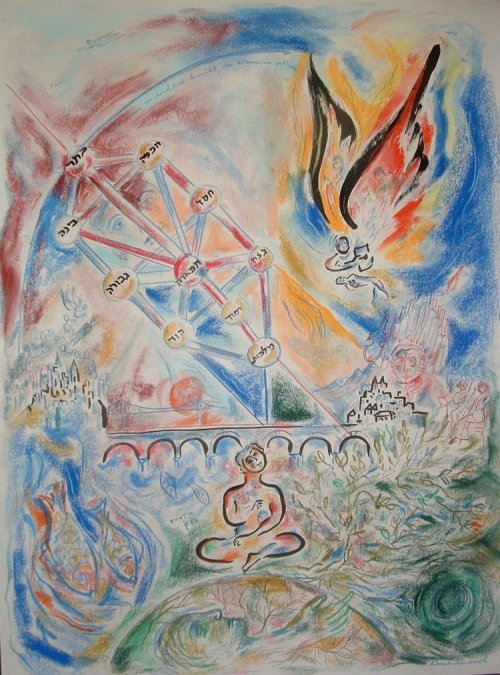
|
|
Bach and the Sefirot, pastel and ink on paper |
|
While I am painting, I usually listen to classical music. I have been doing this since I can remember, when I was still living in my parents’ house in Holland. I grew up with Bach, Beethoven, Mozart, Brahms and Tchaikovsky, Baroque music and opera. We went to concerts. Of all the musical genres, I still like classical music the most. At University I spent a hefty part of my monthly stipend on a subscription to a series of classical piano performances by Alfred Brendel. That’s how important music is to me. Kosher food for Pesach (expensive here, but a fortune in Europe during the ‘80s), took another hefty piece out of those stipends. What was left over, was spent on books.
Most of my drawings have Jewish subjects. My heart is in that, and those subjects are on my mind, because I live them and study them. So, the classical music which I hear all the time in my mind and my aesthetic emotions are connected to the Jewish stories I read. When I made this drawing: Bach and the Sefirot, I had just attended a lecture about Sefirot, and had also recently met with a friend from Europe and talked about Bach. I listened to Bach’s music in my studio. The resulting artwork, which was inspired by both the lecture and Bach’s music, was presented to my European friend as a gift.
Another example is a Mozart drawing I made long ago during the ‘80s in Holland: The composer sits at the piano, and plays one of his beautiful piano concertos. In the background is a Dutch shul, in the top right corner a Seder, and the collage in the middle contains fragments of poems by the 17th century Sephardic poet, Rabbi Selomoh d’Oliveyra of Amsterdam. My father came into the room when I was making this, and asked me what I was doing. The Seder he understood, it was right before Pesach; the poetry he understood, because I was writing an article about that. But what, he asked, did Mozart, a gentile composer from Austria of all places, have to do with it? |
|
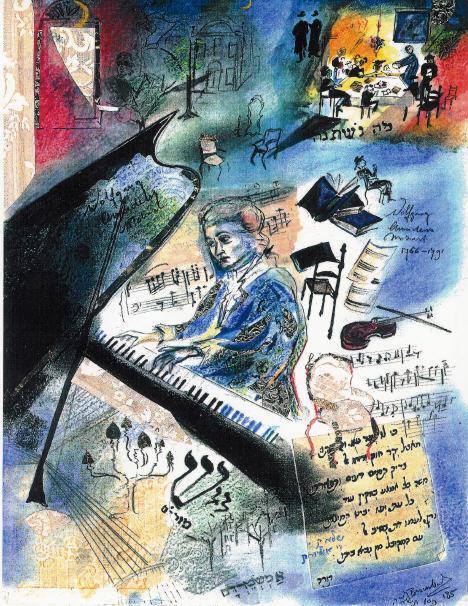
|
|
Mozart. Pastel, ink and collage on paper |
|
For me, they all belonged to what I was occupied with at that time: Pesach, the shul, the poetry of Rabbi d’Oliveyra and the music I listened to, in this case: Mozart. I do not like to paint composers without my own elements in the drawing, without adding what is important for me. The lives of composers are much less inspiring to me than those of le-havdil, Chassidic rabbis. So when I make a portrait of a composer, I add scenes of cities where I lived or where I attended concerts, read books and thought thoughts, Chassidic stories, or experiences I had. Beethoven and Shabbos candles on the same canvas are very normal to me. Compare it to the niggunim, which were often derived from secular songs, like the Kalever niggun which was sung by Hungarian shepherds when the Kalever Rebbe heard it for the first time: |
|
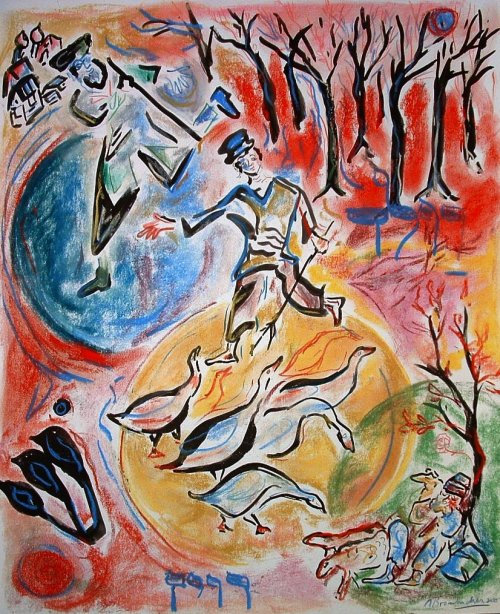
|
|
The Kalever Niggun, pastel and iknk on paper |
|
Niggunim express the soul, and so does music express my soul when I paint. I often listen to Breslover niggunim, or to compositions by Lewandowsky, but also to the cello sonatas of Brahms, or to Moscheles.
Some music will be forever connected to certain books or subjects in my mind. For instance, my mother had a record with the violin concertos of Mendelssohn and Bruch. They are beautiful. They are deeply emotional. I listened to it over and over while I was reading the story of the “Golem of Prague”, and later I made this painting: |
|

|
|
The Golem of Prague, oil on canvas |
|
I put a violin in it, which represents the music of Mendelssohn, even though the stories of the Golem which I read did not deal with music, or with Mendelssohn, or with violins for that matter. Years later I visited Prague, and I kept hearing the violin music in my head. Many of my Jewish paintings show violins or pianos. They accompany me wherever I go.
These three works: Bach and the Sefirot, Mozart, and The Golem are examples of a Jewish theme with classical music in it. Sometimes, I compose ‘pure’ music paintings, usually based on a certain composer, like Beethoven. Do they contain ‘Yiddishkeit’? Some do, and some don’t, as this is a rather subjective subject. I give you an example.
I created the following oil painting in behalf of a fundraising auction for the Children’s Hearing Institute in New York City. Our son was born deaf. He uses a cochlear implant and B”H, excels academically in an Orthodox Yeshiva. He delivered a very meaningful and beautiful Bar Mitzvah speech a year ago and layned his parsha. If you hear him, you cannot tell that he is deaf. He enjoys listening to the cello sonatas of Bach and klezmer music, and to Beethoven. Soon after receiving his cochlear implant, our son required several years of intensive auditory training and speech therapy, which required me to pick him up from school, bring him to Manhattan and back to Brooklyn, several times a week. I did not paint much then. There just wasn’t any time. But I never stopped thinking about painting.
His cochlear implant surgeon is the founder of this charitable institute. The choice for a painting was easy: Beethoven was a great composer, and he became deaf nearly two centuries before the idea of cochlear implants even existed. It must have been a painful disaster for him. He composed in his head. His famous Ninth Symphony he wrote, but never was able to hear it himself. He did not have the possibilities our son Yoni and thousands of others have. I called the work “The Spiral of Sound”, based on the shape of the cochlea in the ear, and the growing amount of sounds an implanted person is able to hear. I also thought about my own situation: I do not hear well, it is getting worse, I would dearly miss my music, and that would affect my art. But in the worst (or best!) case I get a cochlear implant, too, and won’t have to miss a note from the Brandenburger Concertos.
There are no clear and obvious Jewish elements in this painting. But people who are familiar my work, will recognize the ‘water and fire’ which I use often, since in Gemara they are said to be the two components of heaven. They will also recognize my use of the four elements and the bridge (“Gesher Tzar Me’od”) which I include in much of my work. The musicians have ‘Jewish’ features and postures. Of course, this is open to everyone’s personal interpretation, but I heard it often. The “dancing mal’akhim”, are some of the same elements of this painting that appear in my major ‘Jewish’ works as well, such as the “Breslover Tikkun” (posted earlier on this blog), for which this was a sketch: |
|
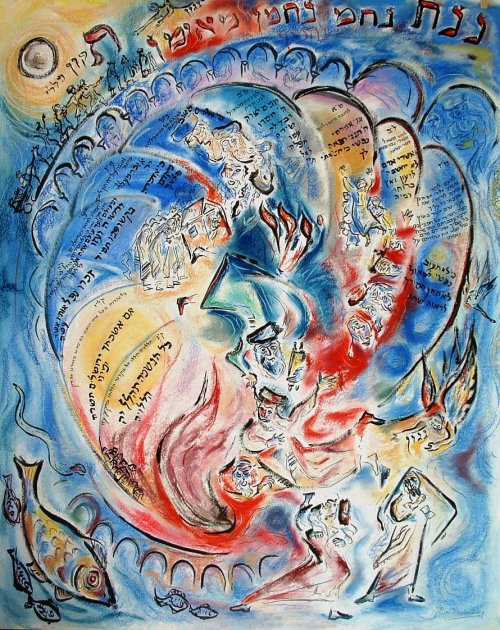
|
|
“The Breslover Tikkun”, sketch for an oil painting in pastel and ink on paper |
|
Compare the sketch to Beethoven: |
|
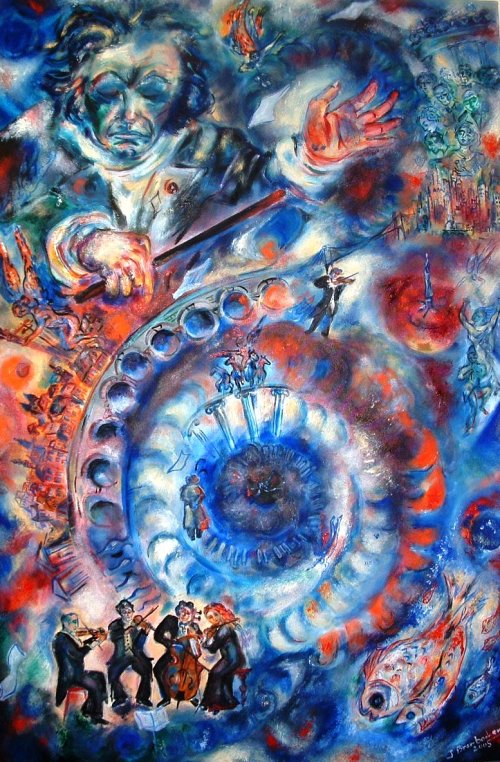
|
|
“Beethoven, the Spiral of Sound”. Oil on canvas |
|
This painting is very representative for my style, but not for my subject matter, which is very ‘Jewish’.
I said earlier that I hear music in my head while I paint Jewish (or any other) subjects. But the reverse is also true. While I hear Beethoven, I think of Jewish subjects. I even wondered about the Three Weeks: I refrain from listening to music (difficult, yes! But what can you do?) but the music in my head keeps coming to me. Is that bad?
Let me make a final remark. It is very important for an artist to be in the right state of mind while working. You can compare it to davening; just going through the motions leads you nowhere. Painting for me is davening. I need concentration and I need devekut. I also need ‘hitbodedut’ with my . I have to be careful what I read or study or see, with whom I talk (and about what!), it all influences me. I cannot paint well, when people are around, the phone is ringing and household chores distract me. The following pastel I made on a recent Friday morning. |
|
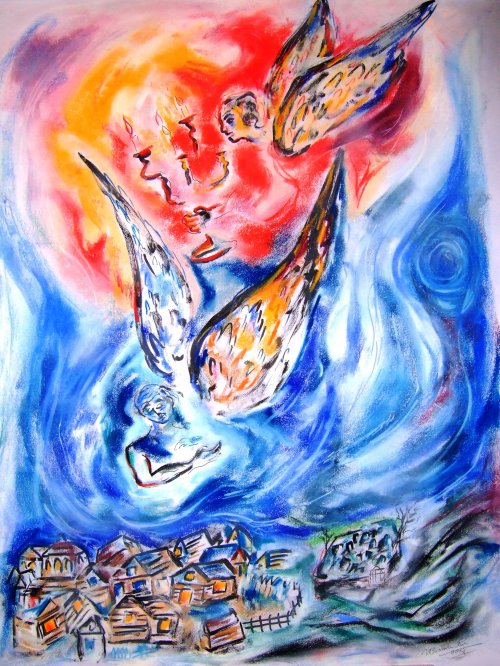
|
|
mal’akhe ha-sharet, mala’khe ha-shalom, pastel and ink on paper |
|
All the Shabbes food was already cooked. The house was ready. I went to my studio, a garage about 4 minutes walking distance away from my apartment, which wonderful friends let me use for my bigger works. I kept thinking about food, and groceries, and guests. But as soon as I was alone there, and locked the door behind me and stood in front of a blank piece of sketching paper, my inspiration came. Shabbos was coming, so were the angels, the Mal’akhe Ha-Sharet, Mal’akhe Ha-Shalom in the song. When I see a white piece of paper I see colors, and I hear a melody. I sang the song a couple of times. I started drawing. Then I stopped singing and put on the little radio I keep in my studio. I was lucky, it played Baroque music. I got totally wrapped up in my work, with so much hitlahavut that you could hear the wings of the angels. I forgot the time. The flames came into the drawing, in bright red and deep blue and warm yellow. Only after the drawing was finished I woke up, and packed up my stuff, locked up for Shabbos, and went home to take care of the last preparations.
At home I think rationally, pay bills, wash dishes, help with homework and listen to music. For me painting and music are inseparable. So could I work on totally separate Jewish paintings and separate music paintings? I don’t thinks so. You don’t split yourself.
There is much more to say about this subject: about Jewish and non-Jewish composers, secular music and chazanut or klezmer, the reason why artists paint certain subjects, etc. Sometimes it’s as simple as getting a commission and needing the money to buy food and paying for a few children’s yeshiva tuitions. So if they ask for a Beethoven, you paint a Beethoven. I am curious to hear your opinion about this.
Shoshannah |
|
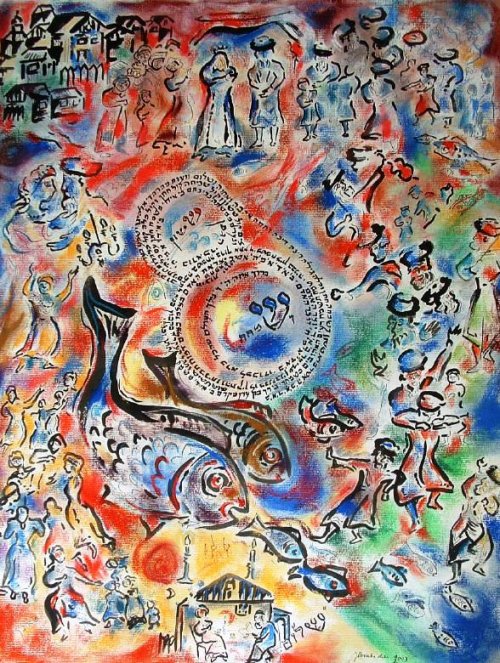
|
|
Music and musicians in a sheva brokhes drawing |
| |
|
Contributed by Shoshannah Brombacher (November 21, 2008) |
|
Shoshannah Brombacher - Hommage a Bach
|
|
|